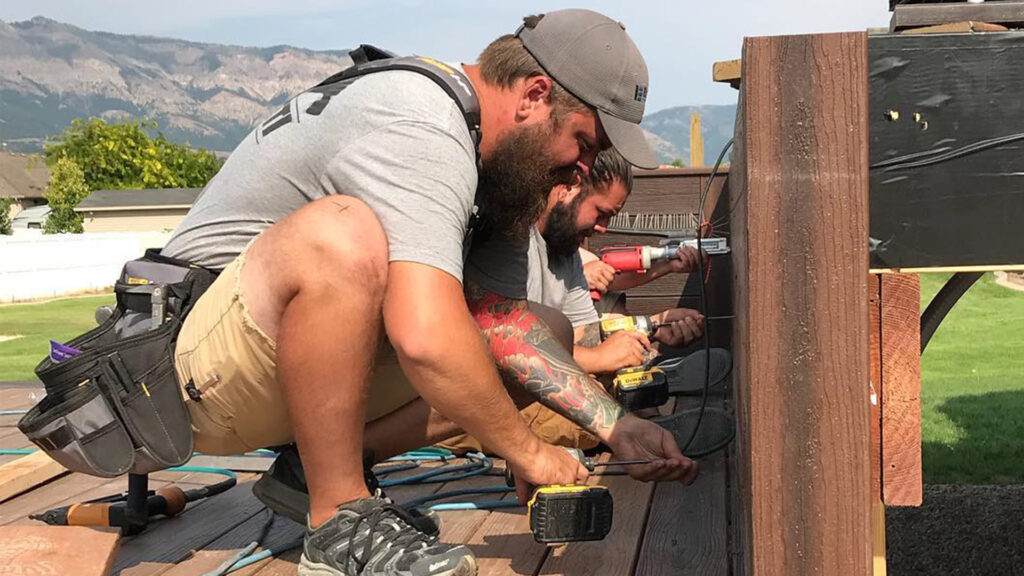7 Essential Decking Tips for Deck Safety Month
May is Deck Safety Month–just in time for decking season. We reached out to pros who have proven experience building outdoor living spaces for advice that can be used for your next project. After going through their feedback, we narrowed it down to seven essential deck safety tips that apply to every project.

1. Design Your Deck to Have Drainage and Ventilation
One of the top causes for any part of a wooden decking surface or substructure to fail is rot. If there are areas of a deck that are trapping moisture or humidity, there’s a higher risk for that part of the structure to weaken and create a safety hazard. Whether you’re a DIYer or pro, it’s important to always have a reliable source of airflow under a deck. You can also use flashing tape on areas where two materials are touching to eliminate the risk of moisture building up and causing rot. Ideally, you want any water or moisture to evaporate as quickly as possible to reduce the chances of the deck frame degrading.
Deck Safety Tip Provided By: Sias Parsons, Founder of Big Yeti Builders
2. Make Sure You Properly Attach the Ledger Board
A ledger board that hasn’t been installed correctly is the most common cause for a deck to fail. Since the ledger board is the main connection between the house and deck, using only nails increases the risk of collapsing. It’s recommended for DIYers and pros to use metal fasteners for more reliable performance. Make sure you calculate the expected weight load being put on the ledger board so you can install the right number of fasteners.
Deck Safety Tip Provided By: Envision expert
3. Trade In Carriage Bolts for Proper Deck Fasteners
Even though carriage bolts got their fair share of usage, it’s best to avoid them. They are no longer code compliant for connecting support beams to deck posts. In fact, carriage bolts tend to loosen, increasing the risk of the deck becoming unstable. When you’re building a new deck, it’s best to use modern deck fasteners. And if you’re updating an existing outdoor living space, be sure to inspect the attachment assemblies. You’ll want to upgrade any connections that are outdated like ones that use carriage bolts.
Deck Safety Tip Provided By: Tom Weed, Deck Dudez
4. Leverage Building Codes and Lighting for Fall Protection
A fall is a very common safety risk on a deck. There are a couple of ways to reduce the risk of a fall, and it starts with building codes. It’s good deck building practice to only install handrails that meet or exceed the specific building codes in your local area. By following railing guidelines, you’ll make the entire outdoor living space safer.
Lack of light is another frequent culprit for causing falls, especially when it comes to stairs. It’s one of the reasons why more deck building pros like to inlay lighting into deck stairs. Stair lighting makes it easier to see possible tripping hazards in the evening. You can even continue this trend by incorporating more lighting in the main deck area and the railing itself.
Deck Safety Tip Provided By: David C. Schwank, Owner of Mosaic Outdoor Living
5. Don’t Compromise on Quality Deck Building Materials
An important deck safety tip really comes down to the materials being used. The quality of the deck products you use plays a big role in how safe the structure will be over the years. For example, do research on different composite decking brands. Ideally, you’ll want deck boards that have proven performance in your specific climate and stand the test of time. The same logic applies to deck railing. By doing more product research up front, your deck is more likely to have a longer lifespan.
Deck Safety Tip Provided By: Sias Parsons, Founder of Big Yeti Builders
6. Build Around Your Local Climate
Speaking of deck lifespans, it’s important to understand how your local climate affects different building materials. For example, the surface of some deck boards in climates with full sun could become painful to walk on after prolonged exposure. In this scenario, building the outdoor living space with composite decking designed to stay cool would improve the deck’s safety. Many composite decking and railing manufacturers will provide guidance on what climates their products work best in.
Deck Safety Tip Provided By: Sias Parsons, Founder of Big Yeti Builders
7. Engineer Your Deck to Have the Same Load Requirements as Your Living Room
Most decks are designed to meet the same load requirements as a living room. As a rule, never do anything on a deck that you wouldn’t do in a living room. For example, if your outdoor living space is going to have a hot tub, your deck needs to have additional support built in. With any deck, it’s important to know the maximum weight it can handle.
Speaking of deck supports, we recommend spanning at least three floor joists in the substructure of your deck. A deck with only two floor joists has a higher risk of failure, especially if extra weight is added on from planters, furniture, or other decor.
Deck Safety Tip Provided By: Caleb Hunt, Owner of Creative Concepts & Designs
Start Your Next Project Off Right with Envision Outdoor Living Products
With these seven Deck Safety Month tips, you’re ready for the building season! Get your next outdoor living project started off on the right foot with help from Envision. Find your unique style with our idea gallery and get started on your decking building material research by ordering a sample today.





















